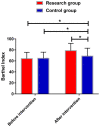The effect of fluoxetine combined with repetitive transcranial magnetic stimulation on the psychological emotions and cognitive and neurological functions of acute post-stroke depression patients
- PMID: 34786118
- PMCID: PMC8581883
The effect of fluoxetine combined with repetitive transcranial magnetic stimulation on the psychological emotions and cognitive and neurological functions of acute post-stroke depression patients
Abstract
Objective: This research was designed to probe into the effects of fluoxetine combined with repetitive transcranial magnetic stimulation (rTMS) on the psychological emotions and the cognitive and neurological functions of acute post-stroke depression patients.
Methods: This experiment recruited 115 acute post-stroke depression patients who were treated in our hospital from February 2018 to April 2020 as the study cohort. 55 of the patients were treated with fluoxetine, and 60 were treated with fluoxetine combined with rTMS. Both groups were treated for 2 months. The self-rating anxiety scale (SAS), the self-rating depression scale (SDS), the National Institutes of Health stroke scale (NIHSS), the mini mental state scale (MMSE), the Barthel index, and the quality of life scale (SF-36) scores were observed.
Results: Compared with the control group (CG), the SAS, SDS, and NIHSS scores in the research group (RG) decreased, while the MMSE and Barthel index scores increased (P < 0.05). After the treatment, the SF-36 scores in the RG were higher than they were in the CG (P < 0.05).
Conclusion: Fluoxetine combined with rTMS can effectively improve the psychological emotions and the cognitive and neurological functions of acute post-stroke depression patients, so it is worthy of clinical promotion.
Keywords: Fluoxetine; acute stroke; cognitive function; neural function; psychological emotion; repetitive transcranial magnetic stimulation.
AJTR Copyright © 2021.
Conflict of interest statement
None.
Figures



Similar articles
-
[Health-related quality of life assessment in depression after low-frequency transcranial magnetic stimulation].Encephale. 2014 Feb;40(1):74-80. doi: 10.1016/j.encep.2013.04.004. Epub 2013 Oct 1. Encephale. 2014. PMID: 24091070 French.
-
Repetitive transcranial magnetic stimulation is as effective as fluoxetine in the treatment of depression in patients with Parkinson's disease.J Neurol Neurosurg Psychiatry. 2004 Aug;75(8):1171-4. doi: 10.1136/jnnp.2003.027060. J Neurol Neurosurg Psychiatry. 2004. PMID: 15258224 Free PMC article. Clinical Trial.
-
Effectiveness of repetitive transcranial magnetic stimulation (rTMS) after acute stroke: A one-year longitudinal randomized trial.CNS Neurosci Ther. 2017 Dec;23(12):940-946. doi: 10.1111/cns.12762. Epub 2017 Oct 2. CNS Neurosci Ther. 2017. PMID: 28971620 Free PMC article. Clinical Trial.
-
Psychological Stress Analysis to Evaluate the Effects of Transcranial Magnetic Stimulation on Mood Regulation and Quality of Life in Patients with Bipolar Disorder.Actas Esp Psiquiatr. 2024 Apr;52(2):130-137. doi: 10.62641/aep.v52i2.1555. Actas Esp Psiquiatr. 2024. PMID: 38622010 Free PMC article.
-
Is Fluoxetine Good for Subacute Stroke? A Meta-Analysis Evidenced From Randomized Controlled Trials.Front Neurol. 2021 Mar 22;12:633781. doi: 10.3389/fneur.2021.633781. eCollection 2021. Front Neurol. 2021. PMID: 33828519 Free PMC article.
Cited by
-
Non-Invasive Brain Stimulation Progression in Post-Stroke Depression Treatment: A Systematic Review.Alpha Psychiatry. 2024 Sep 1;25(5):626-634. doi: 10.5152/alphapsychiatry.2024.241646. eCollection 2024 Sep. Alpha Psychiatry. 2024. PMID: 39553496 Free PMC article.
-
Comparative efficacy of non-invasive brain stimulation for post-stroke cognitive impairment: a network meta-analysis.Aging Clin Exp Res. 2024 Feb 12;36(1):37. doi: 10.1007/s40520-023-02662-x. Aging Clin Exp Res. 2024. PMID: 38345751 Free PMC article.
-
Effectiveness of Transcranial Magnetic Stimulation on Executive Function, Attention, and Memory in Stroke Patients: A Systematic Review and Meta-Analysis.Cureus. 2024 Dec 6;16(12):e75194. doi: 10.7759/cureus.75194. eCollection 2024 Dec. Cureus. 2024. PMID: 39759598 Free PMC article. Review.
-
Antidepressant class and concurrent rTMS outcomes in major depressive disorder: a systematic review and meta-analysis.EClinicalMedicine. 2024 Jul 27;75:102760. doi: 10.1016/j.eclinm.2024.102760. eCollection 2024 Sep. EClinicalMedicine. 2024. PMID: 39170936 Free PMC article.
-
Influence of Evidence-Based Nursing on Psychological Status, Neurological Function, and Life Quality of Patients with Acute Poststroke Depression.Dis Markers. 2022 Sep 16;2022:7099908. doi: 10.1155/2022/7099908. eCollection 2022. Dis Markers. 2022. PMID: 36157215 Free PMC article.
References
-
- Frontera JA, Lewin JJ 3rd, Rabinstein AA, Aisiku IP, Alexandrov AW, Cook AM, del Zoppo GJ, Kumar MA, Peerschke EI, Stiefel MF, Teitelbaum JS, Wartenberg KE, Zerfoss CL. Guideline for reversal of antithrombotics in intracranial hemorrhage: a statement for healthcare professionals from the neurocritical care society and society of critical care medicine. Neurocrit Care. 2016;24:6–46. - PubMed
-
- Qureshi AI, Palesch YY, Barsan WG, Hanley DF, Hsu CY, Martin RL, Moy CS, Silbergleit R, Steiner T, Suarez JI, Toyoda K, Wang Y, Yamamoto H, Yoon BW ATACH-2 Trial Investigators and the Neurological Emergency Treatment Trials Network. Intensive blood-pressure lowering in patients with acute cerebral hemorrhage. N Engl J Med. 2016;375:1033–1043. - PMC - PubMed
-
- Tsivgoulis G, Zand R, Katsanos AH, Turc G, Nolte CH, Jung S, Cordonnier C, Fiebach JB, Scheitz JF, Klinger-Gratz PP, Oppenheim C, Goyal N, Safouris A, Mattle HP, Alexandrov AW, Schellinger PD, Alexandrov AV. Risk of symptomatic intracerebral hemorrhage after intravenous thrombolysis in patients with acute ischemic stroke and high cerebral microbleed burden: a meta-analysis. JAMA Neurol. 2016;73:675–683. - PubMed
LinkOut - more resources
Full Text Sources
Miscellaneous
